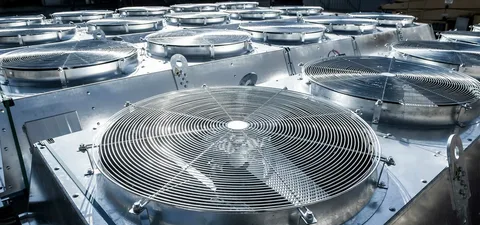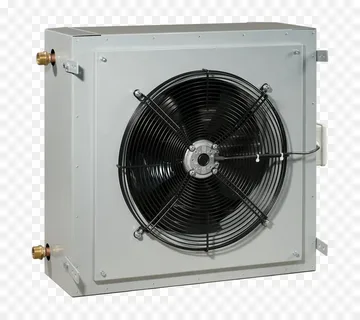Ensuring optimal air quality in indoor environments, such as our residences and offices, is integral to our holistic health. Inferior air circulation can cause or exacerbate various respiratory conditions and allergies. Consequently, it becomes indispensable to install and maintain effective ventilation systems. The crucial parts of a heat exchange ventilation fan include the heat exchangers, which moderate temperature by transferring heat between air flows, and ventilation fans that facilitate air circulation.
Heat Exchanger Fan Can Boost Energy Efficiency And Cost Savings
Heat exchanger fan play a vital role in maintaining good air quality and promoting healthy living. One major benefit of these fans is their ability to boost energy efficiency and save costs. How do they achieve this? Let’s dive into it.
Heat exchange fans work by transferring heat from one space to another, allowing for a more balanced and controlled temperature throughout your home or workplace. By distributing heat evenly, they reduce the strain on your heating and cooling systems, resulting in reduced energy consumption and lower utility bills. This is especially beneficial during extreme weather conditions when heating or cooling systems tend to work harder to maintain a comfortable indoor environment.
Additionally, heat exchange fans help prevent energy loss by recovering and reusing heat that would otherwise be wasted. They capture the heat from outgoing stale air and transfer it to incoming fresh air, ensuring that energy is not wasted in the ventilation process. This heat recovery mechanism significantly reduces energy wastage and increases energy efficiency, ultimately saving you money on energy costs.
Enhancing Comfort And Preventing Structural Damage
One of the key benefits of heat exchange and ventilation fans is their ability to enhance comfort and prevent structural damage in our homes and workplaces. These fans play a crucial role in maintaining optimal airflow, which directly affects our overall well-being and the condition of our buildings.
 First and foremost, proper airflow provided by these fans helps to regulate the temperature and humidity levels in our living spaces. By circulating air effectively, heat exchange and ventilation fans can create a more comfortable and pleasant environment, especially during hot summer months or cold winters. This ensures that we can enjoy our homes and workplaces without experiencing extreme temperatures or excessive humidity, which can be detrimental to our health and comfort.
First and foremost, proper airflow provided by these fans helps to regulate the temperature and humidity levels in our living spaces. By circulating air effectively, heat exchange and ventilation fans can create a more comfortable and pleasant environment, especially during hot summer months or cold winters. This ensures that we can enjoy our homes and workplaces without experiencing extreme temperatures or excessive humidity, which can be detrimental to our health and comfort.
Furthermore, the consistent airflow facilitated by these fans helps prevent the buildup of moisture, which can lead to mold and mildew growth. Mold and mildew not only cause unpleasant odors and damage to our belongings but can also contribute to respiratory problems and allergies. By preventing excess moisture, heat exchange and ventilation fans safeguard the structural integrity of our buildings, reducing the risk of costly repairs and health hazards.
Understanding The Home Ventilator Cost: A Comprehensive Guide
When it comes to choosing a home ventilator, understanding the cost factors is crucial. This comprehensive guide will walk you through everything you need to know about the home ventilator cost, helping you make an informed decision for your space. First and foremost, it’s important to consider the initial purchase cost of a home ventilator. Prices can vary depending on the type and size of the unit, as well as any additional features or specifications.
It’s recommended to research different brands and models to find the one that best suits your needs and budget. In addition to the purchase cost, it’s important to factor in the installation expenses. Some home ventilators may require professional installation, while others can be easily set up by the homeowner. Professional installation may come with additional costs, so it’s essential to budget for this as well.
Another aspect to consider is the ongoing maintenance and operation costs. Home ventilators may require regular filter replacements or servicing to ensure optimal performance. It’s important to factor in these expenses to understand the long-term costs associated with owning a ventilator.
Air Ventilation Unit Can Contribute To Environmental Sustainability
In our quest for healthy living, it’s important to consider not just our well-being but also the well-being of the planet. This is where air ventilation unit come into play. These units, often used in commercial and industrial settings, can contribute significantly to environmental sustainability.
By implementing an efficient air ventilation system, you can ensure that fresh air is consistently circulated throughout your space. This not only improves the indoor air quality for occupants but also reduces the reliance on air conditioning and heating systems, which consume large amounts of energy.
By decreasing energy consumption, we can decrease our carbon footprint and reduce greenhouse gas emissions, helping combat climate change. In addition to reducing energy consumption, ventilation units also help in reducing the need for artificial lighting. Natural light, coupled with good air circulation, can create a more comfortable and pleasant environment, ultimately reducing the need for excessive artificial lighting. This further saves energy and promotes a sustainable lifestyle.
Overall, air-ventilation units are an important component of promoting environmental sustainability. By optimizing indoor air quality and reducing energy consumption, these units contribute to a healthier and greener planet. So, when considering options for maintaining optimal airflow in your space, don’t forget to consider the positive impact it can have on the environment.
Maximizing Air Circulation For Healthier Living
When it comes to creating a healthy and comfortable living environment, maximizing air circulation is key. Good air circulation ensures that fresh air is constantly flowing throughout your space, removing any stagnant air or pollutants that can negatively impact your health.
There are several ways to maximize air circulation in your home or workplace. First, make sure to keep windows and doors open whenever possible to allow for natural ventilation. This allows fresh air to enter and circulate throughout the space.
Additionally, using ceiling fans or portable fans can help promote air movement, keeping the air feeling fresh and preventing it from becoming stale. Another important factor in maximizing air circulation is proper maintenance of your ventilation systems. Make sure to clean or replace air filters regularly to ensure optimal airflow. Clogged or dirty filters can restrict air movement and reduce the effectiveness of your ventilation system.
Lastly, consider investing in a heat exchange or ventilation fan. These fans are specifically designed to promote air circulation and improve indoor air quality. They work by drawing in fresh air from outside and expelling stale air, ensuring a constant flow of fresh air throughout your space. These fans can be especially beneficial in areas with poor natural ventilation or high levels of pollutants.
Improving Air Circulation With Industrial Ventilation
Improving air circulation is crucial for maintaining a healthy and comfortable living or working environment. In spaces where natural ventilation is limited or insufficient, industrial ventilation systems can be a game-changer. These systems are specifically designed to maximize airflow and improve indoor air quality.
Ventilation utilizes powerful fans and ductwork to remove stale air and pollutants and replace them with fresh air from the outside. By continuously circulating fresh air, ventilation systems ensure a constant flow of clean air throughout the space. This helps remove allergens, dust, and other airborne contaminants, promoting a healthier and more comfortable environment for occupants. One key advantage of ventilation systems is their ability to target specific areas or zones within a building.
By strategically placing fans and ducts, these systems can optimize airflow in areas that require it the most, such as kitchens, bathrooms, or workspaces with high pollutant levels. This targeted ventilation approach helps improve air quality where it matters most, ensuring the well-being and comfort of occupants. Furthermore, ventilation systems can also assist in controlling temperature and humidity levels. By exhausting hot or humid air and introducing fresh air, these systems help regulate the overall climate within a building.
Optimizing Indoor Air Quality: A Guide To Ventilation Installation
Are you looking to optimize the air quality in your home or workplace? One important aspect to consider is the installation of a ventilation system. To help you navigate the process, we have created a comprehensive guide to ventilation installation. First, it’s essential to assess your specific needs. Consider factors such as the size of your space, the number of occupants, and any specific ventilation requirements. This will help determine the type of ventilation system that is best suited for your needs.
Next, you’ll need to choose the right ventilation system for your space. There are various options available, including mechanical ventilation systems and natural ventilation systems. Mechanical systems use fans or blowers to circulate air, while natural systems rely on the flow of air through open windows or vents. It’s important to weigh the pros and cons of each option to determine which one is the best fit for your situation.
Once you have selected a ventilation system, it’s time to consider the installation process. Depending on the complexity of the system, you may need professional help for installation. Some systems require specialized knowledge and expertise, so it’s crucial to find a qualified contractor or technician who can ensure a proper installation.
The Exhaust Ventilation System Can Improve Indoor Airflow For Health And Comfort.
Proper ventilation is essential for maintaining a healthy and comfortable living or working environment. One effective way to improve indoor airflow is by utilizing an exhaust ventilation system. This system works by removing stale air and pollutants from the space, creating a constant flow of fresh air.
An exhaust-ventilation system consists of fans and vents that are strategically placed to effectively expel stagnant air. By continuously removing this air, the system helps prevent the buildup of pollutants, allergens, and odors, ultimately improving indoor air quality. This is especially important in areas such as kitchens or bathrooms, where odors and moisture can accumulate.
In addition to removing stale air, an exhaust-ventilation system also helps control temperature and humidity levels. By expelling hot or humid air and introducing fresh air, the system helps regulate the overall climate within a building. This prevents the accumulation of excess heat or moisture, creating a more comfortable and pleasant environment for occupants.
FAQs
Is The Heat Exchange Ventilation Fan The Same Thing?
No, heat exchange fans and ventilation fans serve different purposes. Heat exchange fans are designed to transfer heat from one space to another, promoting a balanced temperature throughout your home or workplace.
What Are The Benefits Of Using Heat Exchange And Ventilation Fans?
Heat exchange fans boost energy efficiency and cost savings by distributing heat evenly, reducing strain on heating and cooling systems, and recovering wasted heat. They also contribute to a more sustainable environment by conserving energy and reducing greenhouse gas emissions.
How Much Do Heat Exchange And Ventilation Fans Cost?
The cost of heat exchange and ventilation fans can vary depending on factors such as the type, size, and additional features. It’s recommended to research different brands and models to find the best fit for your needs and budget.
Can I Install A Heat Exchange Ventilation Fan Myself?
The complexity of installation will depend on the specific fan and your technical expertise. While some fans can be easily installed by homeowners, others may require professional assistance.
Conclusion
Heat exchange ventilation fans play a vital role in maintaining optimal airflow and promoting healthy living. These fans provide numerous benefits, from boosting energy efficiency and cost savings to enhancing comfort and preventing structural damage. Heat exchange fans are an excellent choice for improving energy efficiency and reducing utility costs. By distributing heat evenly and recovering wasted heat, they help reduce the strain on heating and cooling systems, resulting in lower energy consumption.



